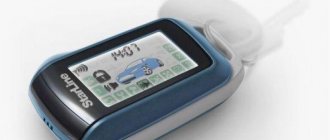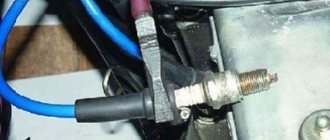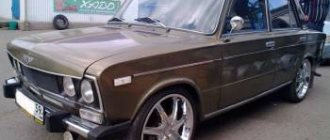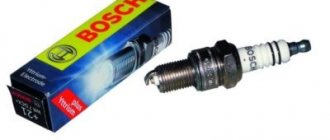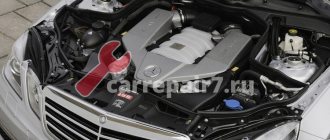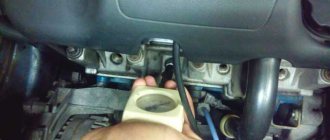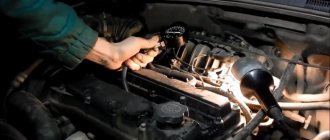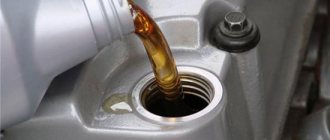VAZ-2106 history of the Soviet and Russian automobile industry. The Volzhsky Automobile Plant produced this model until 2006. Until now, on the roads of Russia, the CIS and far abroad, the “sixes” fulfill their duties, refining their “age” for transporting people.
The older the car, the more often the owner encounters problems starting the engine. There are many reasons why the engine does not start, ranging from a malfunction of on-board electrical equipment, to a malfunction of the fuel supply, even to low-quality gasoline.
This article discusses frequently encountered nuances that make it impossible to start the power unit of the sixth model Zhiguli.
Checking the spark plugs and spark
When the starter is turned on, the crankshaft rotates, but the engine does not start, nor should it be pushed for more than 5 - 7 seconds. Otherwise, during prolonged operation, the starter will overheat and fail, which will cause even more problems.
When the engine is cranked for a long time, the fuel supply system will easily flood the spark plugs with gasoline if, for some reason, they do not work well.
Obviously, startup is not possible. Candles need to be dried. Direct injection engines have a cylinder scavenging option. It helps to dry out the spark plugs to some extent - set the accelerator to full and turn the crankshaft. But this will not give a positive result if the ignition system does not work. You need to make sure there is a spark at the spark plugs.
To check, you need to unscrew the spark plugs, having first removed the tips with wires from them. Then connect the wires to the spark plugs and place them one by one on the head cover, cranking the engine with the starter.
A clearly visible blue spark should appear in the gap between the spark plug electrodes. If there is none on all spark plugs, then you need to explore deeper the ignition system and its elements.
During production, VAZ-2106 was equipped with injection and carburetor engines. The ignition systems and fuel preparation systems of these engines have different designs, and accordingly the types of problems differ. You need to start from simple to complex.
General faults
Common faults include failed spark plugs and high-voltage wires with tips (spark plugs):
- Carbon deposits form on the electrodes of the spark plugs for a number of reasons (poor quality fuel, valve timing is not adjusted, valve seals are not working properly, etc.), which prevents the formation of a spark. In this case, you need to clean the spark plug electrodes, rinse with gasoline and dry. Try to eliminate the cause of soot formation. It is also possible that the insulator between the electrodes may be destroyed - this problem can be solved by replacing the used product with a new one.
- High-voltage wires cease to perform their function when the insulation is broken. A short circuit occurs and the current does not reach the spark plugs. To fix this, replacing the conductors with new ones is the best option.
Malfunctions in injection engines
The lack of spark in injection engines may be due to the failure of the Electronic Control Unit (ECU) or one of its modules (in this case, the Electronic Ignition System).
An error in the operation of the ECU will be indicated by a light on the dashboard with the inscription Chek Engine; it will light up.
You can use a diagnostic scanner; it indicates the error number by which the malfunction is determined.
During diagnosis, the following reasons are most often identified:
- The ignition system module does not work. The main problem is the failure of two transistors responsible for the normal supply of sparks to the spark plugs. It’s difficult to repair it yourself, and not all workshops will do it. It's easier to replace it with a new block.
- There is no power supply to the ignition system module. There are two options. The first is that the ECU fuse is blown (it needs to be replaced), the second is that the ignition switch does not work (the fault in the lock needs to be eliminated, or it needs to be replaced completely).
- The ECU is not working. In this case, the control unit is completely changed.
Malfunctions in carburetor engines
In carburetor engines there are slightly more reasons for the lack of spark at the spark plugs than in injection power units.
Here are the typical reasons for the lack of spark on the spark plugs of a carburetor VAZ-2106:
- There is no power supply to the ignition coil terminal.
One of three reasons:
- The ignition switch is faulty.
- Possible network interruption.
- The fuse responsible for the ignition system has blown.
- The distributor has become unusable. This is a complex mechanism, the operation of which depends on the state of its elements.
The distributor can fail for several reasons:
- The carbon contact brush in the ignition distributor cap has crumbled or stuck.
- The breaker contact group is loose and has a lot of play.
- There is no gap or a large gap on the breaker contacts (should be 0.4 mm).
- The resistor on the slider has failed.
- The distributor cap is cracked.
- The outer contact of the runner plate is burnt.
- The splines on the distributor drive shaft were cut off.
All these problems are eliminated. Some require replacement of elements, and for some, prevention is sufficient.
- Switch malfunction if the engine is equipped with a non-contact ignition system. In this case, the entire unit is replaced or repaired in a special workshop.
These are common failures in the ignition system. If no defects are revealed during its diagnosis, it is necessary to check the system for preparing and supplying the air-fuel mixture.
Cold carburetor car engine does not start
Let's consider the causes of the malfunction - why a cold (not warmed up) carburetor engine of VAZ 2108, 2109, 21099, 2105, 2107 cars does not start. The main culprits will be carburetors 2108, 21081, 21083 Solex, 2105, 2107 Ozone. It should be noted that there are also reasons why a car engine does not start in cold weather, but there is a separate article on our website to describe them. You should also pay attention to the ignition system (2108, 2109, 21099, 2105, 2107), power system, serviceability of the engine itself, etc.
Symptoms of the problem “A cold carburetor engine does not start”
— When the crankshaft is cranked by the starter, the engine does not start.
He shows no signs of life. There are no flashes in the cylinders. — The engine “seizes”, several flashes occur and it stalls.
Causes of the malfunction “a cold carburetor engine does not start”
— There is no fuel in the carburetor float chamber
After a long stay or in the heat, it evaporated. Pump it up using the manual pump lever on the fuel pump.
You can pump fuel into the carburetor float chamber using the manual pump lever on the fuel pump.
— The mesh filter at the inlet to the carburetor is clogged
Details of strainer filters for fuel purification of carburetors 2108, 21081, 21083 Solex, 2105, 2107 Ozone
— Sticking of the needle valve needle in the upper position, which locks the fuel supply
Details of the float chamber of the Solex 2108 carburetor
— The air damper does not close completely when the “choke” handle is pulled out
It is necessary to greatly enrich the fuel mixture during a cold start; if the damper does not completely block the cross-section of the first chamber or does not close tightly, the mixture is not sufficiently enriched because the air flow into the carburetor is too large and the engine does not start.
The air dampers of carburetors 2108, 21081, 21083 Solex, 2105, 2107 Ozone are completely closed
Check the serviceability of the drive parts. Adjust it.
“Adjusting the air damper drive of carburetor 2105, 2107 Ozone” The air damper may become stuck on its axis, or its control lever may jam. Find out the cause of the jamming (contamination, mechanical deformation) and eliminate it.
— The solenoid valve (EMV) is faulty or the fuel jet of the idle system is clogged
In the event of a malfunction, its needle can completely cut off the fuel supply at idle.
Solenoid valves for carburetors 2108, 21081, 21083 Solex, 2105, 2107 Ozone Carburetor solenoid valve design
Also, check how the valve is screwed in, if it is not tight, then tighten it, but do not overdo it, do not tighten it too much as you can crush the fuel nozzle inserted into it or, even worse, the seat in the carburetor cover..
On carburetors with an idle air system fuel jet holder, unscrew the holder and check if the fuel jet is clogged. Remove the blockage and blow it out with compressed air.
— “Suction” of foreign air into the carburetor
The image shows the probable culprits of the “suction” of foreign air into the carburetor 2108, 21081, 21083 Solex.
Places of possible “suction” of foreign air into the carburetor 2108, 21081, 21083 Solex
— The starting device is incorrectly adjusted
It should slightly open the closed air damper when starting the engine, increasing the flow of air into the carburetor, preventing the fuel mixture from becoming overrich during the first flares in the cylinders. Also, do not forget that the throttle valve of the first chamber of the carburetor must be slightly open to a certain clearance when the starter is cocked.
Starting devices for carburetors 2108, 21081, 21083 Solex, 2105, 2107 Ozone
— The needle valve of the float chamber is not sealed
A leaky valve causes fuel to overflow, the mixture becomes excessively rich, and the spark plugs are flooded.
Replace the assembly; rubber-tipped needles are commercially available. If you come across a normal one, you can forget about repairs for a long time.
Articles on the website on the needle valve:
Checking the needle valve with vacuum on carburetors 2105, 2107 Ozone, 2108, 21081, 21083 Solex
— Fuel level is incorrectly adjusted
As a result of incorrect adjustment of the fuel level in the float chamber or damage to parts of the float device (stop valve floats), the fuel mixture may become over-rich or, conversely, over-lean, and the engine will not start as a result.
Approximate fuel level in the float chambers of carburetors 2108, 21081, 21083 Solex, 2105, 2107 Ozone
Adjust the fuel level in the float chamber:
— The fuel or air nozzle of the main metering system of the first chamber is clogged
Remove the carburetor cover, unscrew the air jets, unscrew the fuel jets of both chambers, remove the diffusers. Wash them with acetone, clean them with a thin wire or wooden stick, and blow with compressed air.
GDS elements of carburetor 2105, 2107 Ozone
We carry out a similar cleaning on the 2108 Solex carburetor.
GDS elements of carburetor 2108, 21081, 21083 Solex
Notes and additions
Before looking for the reasons why a cold carburetor engine does not start, you should check the ignition system, as the engine may not start due to its malfunction.
Source
Checking the gasoline supply
For engines with different mixture formations, diagnostics will be different.
Carburetor engines VAZ-2106
The main and most common malfunctions of the fuel system are:
- Fuel line clogged.
- Fuel pump failure.
- Damage to the carburetor or its components.
Diagnostics should begin with the carburetor, check the gasoline supply. To do this, you need to remove the cover from the air cleaner housing so that the insides are visible. Use the damper lever to simulate gas flow and see if fuel is sprayed from the atomizer. If it is sprayed, then there is no problem with the supply of gasoline; if it is not sprayed, then you need to inspect the fuel line and the fine fuel filter (often clogged with dirt).
The sore spot in the fuel system of the Zhiguli carburetor engine is the fuel priming pump. The most common places to wear out are:
- drive cam – subjected to grinding;
- the pusher is also ground down at the point of contact with the cam;
- the intake valve hangs, corrosion appears on the belt.
To check the functionality of the fuel pump, simply remove the hose going to the carburetor from the fitting and crank the engine with the starter. When the pump is working, gasoline will flow from the tube.
If all these actions were unsuccessful, then most likely you need to pay attention to the carburetor. This is a complex mechanism and, without experience, it will be difficult to check or repair it yourself. It is better to give this work to experienced craftsmen.
A common problem is clogging of the channels and jets in the carburetor system. It should be washed with a spray for cleaning carburetors when removed and disassembled. Again, it is better to do it at a service station where there is a special bath for washing and a compressor for purging.
Injection engines VAZ-2106
On engines with direct injection, checking the supply of gasoline to the system is easier. At the end of the fuel rail there is a valve covered with a cap. This valve relieves pressure in the fuel supply system by pressing it. When pressed, gasoline should come out of the valve hole.
After relieving the pressure, turn on the ignition, the fuel pump should start, restoring pressure. If it doesn't work, then that's the reason:
- there is no power supply to the pump (fuse blown, network break, etc.);
- failure of the pump (wear and tear, burnt-out electric drive, etc.).
If it works, but the effect is still the same (the engine does not start), you need to check the pressure regulator (possibly water got in and froze) and the presence of power supply to the injectors (should be 12V).
After diagnosing the fuel system and correcting problems in it, the engine still does not start. We will have to look for reasons in another system involved in the process of preparing the air-fuel mixture.
Gasoline pump
Before performing the check, you must make sure that a fuel filter is installed in the vehicle.
The quality of domestic gasoline is very far from ideal, so you cannot do without these elements. If you pump the pump with your hands, fuel should move in the fuel filter. If it is dry, then experts and experienced drivers recommend looking for air leaks in the line. This malfunction occurs quite rarely, but it does happen. If nothing resists while pressing the lever, then turn the engine crankshaft half a turn.
Checking the air supply
The air intake system rarely causes problems. If they happen, it is due to negligence and untimely maintenance. There are few reasons:
- Completely clogged filter element. To check, you need to remove the cover from the filter housing and make sure that the filter element is clean. If it is dirty, change it for a new one.
- The suction pipe or air inlet thermostat is clogged. Remove, clean and reinstall.
- The air channel is clogged (rag, etc.). This can happen on purpose or due to negligence during repairs. To check, the air filter housing and carburetor are removed, the air duct (suction manifold) is inspected, and what is not needed is removed.
This is what concerns ignition and fuel preparation systems. There are a number of other reasons why the VAZ-2106 engine does not start. It won’t be difficult to diagnose the problem yourself and, if necessary, fix the problem.
Carburetor check
You need to open the air filter cover, turn on the ignition, and press the gas pedal. An assistant should look into the manifold to see if fuel is flowing.
If it does not pass, the block needs to be washed.
- The carburetor is flushed after its removal using a special flushing liquid.
- For this you will need a compressor and a special bath.
After disassembly and possible replacement of component parts, installation and adjustment of the carburetor is required. It is better to use the services of a car mechanic.
Starter does not turn
When starting the engine, the starter does not rotate. There are several reasons, here are some of them:
- The battery is dead. To check, you need to measure the voltage with a load plug with double load relative to the battery capacity; it should not drop below 9 volts. If there is none, you can tell by the headlights, turn them on and look at them. A bright glow means everything is fine, a dim glow or no light means the battery is dead. To resolve this, you need to charge the battery using a charger.
- There is no contact at the DC power supply terminals. This may have happened due to oxide coating on one of the terminals. In this case, the headlights and instrument panel lights will glow normally, but there will not be enough current to power the starter. To check, you need to lift the hood and inspect the battery, or rather the terminals. They will have a coating similar to snow. The fix is simple: disconnect the terminals, clean the terminals from oxide on the wires and battery with sandpaper, wipe with a rag, lightly apply lithol to the contact surfaces of the terminals (will protect against oxidation), install them in place and screw them tightly.
- The ignition switch is broken. Checking is as easy as shelling pears: disconnect the wires that go to start from the lock terminals, connect them together. If the starter turns over, then the problem is in the lock. It can only be eliminated by replacement, since this unit in Zhiguli cannot be repaired.
- The starter solenoid relay is broken. This breakdown is recognizable by its characteristic features. When trying to start the engine, a clicking sound is made somewhere in the engine compartment, but the starter does not rotate. It is worth additionally checking whether the relay has failed or not. To do this, take a small insulated conductor and connect the terminals on the starter relay, those with large nuts (there are two of them). If the starter shaft rotates, then the relay is not working. It should be replaced. It is better to do this in workshops where there is the necessary special equipment.
- The armature winding on the starter burned out. Or the motor brushes are worn out. In these cases, when you try to start, the starter will not make any clicks. To determine the cause, the unit will have to be removed and diagnosed. If wear of the brushes is confirmed, they can be replaced, this is not difficult, but if there is an interturn short circuit, then the starter needs to be changed.
Checking the performance of the power system
If your car won't start, we suggest starting with diagnosing the power system. It is quite possible to do it yourself. This requires:
Most often, in this very system, the fuel pump fails, which is very sensitive to low-quality fuel. Special filters provide its protection, but over time, the filter elements become clogged and substances enter the pump that negatively affect its operation.
If this is the case, you will need to dismantle the device, thoroughly clean it, install new filters, and only then carry out installation.
Another problem with the fuel pump is air getting into it. To eliminate this problem, you need to very carefully check the entire line, and then eliminate any leaks found.
The engine starts and immediately stalls
There are times when the engine starts and stalls after a few seconds. There are enough reasons, several of them are given at the beginning of the article, but there the engine did not start at all. Let's look at why this happens:
- The fuel pump has failed. Does not supply enough fuel to the gasoline float chamber.
- The fuel line is clogged. Debris in the fuel line acts like a valve, moving in the flow and blocking the line in a bottleneck. This could be a piece of ice in winter.
- Clogged injectors in an injection engine. Solution to the problem: remove the injectors, check, wash if necessary and put them back in place.
- Connects the high-voltage ignition wire to the housing. If one wire shorts, the engine usually stalls during operation. If two wires or the central wire are shorted, the motor starts and stalls. Only a new set of wires will help.
- Worn sprockets and timing chain. This rarely happens, but it does happen. Due to chain elongation and sprocket wear, the valve timing constantly floats, especially if the hydraulic tensioner does not work. It is even possible for the chain to jump on the sprocket. In these cases, a service station and new spare parts are required.
Summary
There are seasonal problems with engine operation. For example, in summer the car does not start because the mixture is too rich, in winter – because it is too lean. In order for the car to work properly and so that the owner does not rack his brain with the question “why does the VAZ 2106 not start”, it is necessary to constantly monitor the proper operation of the carburetor and other important components. Then this classic AvtoVAZ model will delight its owner with stable and impeccable performance.
So, we found out for what reasons the VAZ 2106 car may not start. As you can see, all breakdowns can be fixed with your own hands.
Popping noises when starting the VAZ-2106 engine
It happens that when starting the engine, popping noises are heard, which can be heard both in the carburetor and in the exhaust system. Everything can be fixed, you just need to find out the reason for what is happening.
Popping sounds in the muffler
When the engine “shoots” at the muffler when starting, this means that gasoline has completely filled the spark plugs. It is possible to eliminate this reason. Only the elimination methods are different for different engines. It is described in detail in the chapter “Checking the spark plugs and spark”.
Popping sounds in the carburetor
If you hear popping noises in the carburetor when you start the engine, this means the choke is not working properly. This occurs due to the fact that the damper does not fit tightly to the diffuser body, forming a large gap, allowing a lot of air to pass through, leaving the air-fuel mixture leaner. This causes popping noises in the carburetor. Most often, the cause of this “shooting” is a weakening of the spring, which is installed on the damper rod.
It's easy to check: remove the air cleaner cover, press the valve in the carburetor with your finger and release. It should quickly return to its place and there should be no gaps between the body and the damper. If this does not happen, you need to purchase a repair kit for the carburetor and replace worn parts.
Ignition system
If even after all this the VAZ 2106 does not start, the cause of the malfunction may be in the ignition unit. In order to check for the presence of a spark, remove the tip of the armored wire on the first cylinder.
Then this tip is brought to the motor body approximately 7-8 mm. Next, start the starter and turn the crankshaft. If there is no spark, it is necessary to check the presence of all important voltages.
Poor starting of the VAZ-2106 engine in the cold season
The main problem with starting an engine in winter is frost. Defects that are not noticeable in the cold season in summer complicate startup. Everything freezes, especially the lubricant in the gearbox and gearbox thickens. The fact is that the oil in the engine crankcase is changed after a certain mileage of the car, but the box is forgotten or considered unnecessary. Therefore, in order to somehow facilitate starting the engine, you need to squeeze the clutch all the way.
If the battery is left in the cold for a long time, then a problem will also arise. It may not be charged enough to crank the engine. In this case, you need to have some kind of additional power source or charger.
Hard starting or the engine may not start due to extremely minimal compression in the cylinders. There is a way out of this situation: you need to unscrew the spark plugs, pour five milliliters of oil into each cylinder with a syringe, crank the crankshaft with the starter several times, screw in the spark plugs and try to start. The oil will circulate throughout the cylinder, increasing compression briefly. It’s better if you take care of this in the summer by having the engine overhauled at a specialized service station.
Troubleshooting carburetor problems
Regardless of whether an EMC is installed or not, the procedure for cleaning the idle fuel jet is the same.
In order to remove the XX jet from the radiator body, you will need a 13-size wrench, but depending on the design, a 14-size wrench can also be used. After turning the EMC, remove the nozzle. If the center hole is clogged, carefully clean it with a thin wire or blow it out with compressed air.
Once the fuel jet center channel is clean, reinstall it. Screw in until it stops and tighten carefully with a wrench. Connect the “positive” wire to the power terminal of the EMC. Start the engine.
To make it easier to work with the carburetor, it is necessary to remove the air filter. Turn on the ignition, first removing the power wire from the EMC terminal. Touch the power wire to the valve terminal. A distinct click indicates that power is coming to the EMC input. In this case, the cause of the malfunction should be sought in the jet or in the carburetor itself. The absence of a click indicates that the fault is in the solenoid valve or fuse. To check the valve, connect the “plus” of the car battery to the terminal of the EMC, and the “minus” to its body. If there is no click, the solenoid valve is faulty and must be replaced.
No fuel supply
In addition to problems in the ignition system, the VAZ 2107 engine may experience difficulty starting if there is a problem with the fuel system. Since they are different for injection and carburetor internal combustion engines, the problem is solved differently.
On the injector
If an engine equipped with a fuel injection system does not start due to a lack of gasoline supply (there is enough gasoline in the tank), then the problem lies in the fuel pump.
When the driver turns on the car's ignition, he should hear the sound of the pump. At this moment, the pressure necessary for the operation of the fuel injectors is created in the line. If this sound is not heard, then the engine will not start or will constantly stall.
On the carburetor
If little or no gasoline flows into the carburetor, then checking the fuel pump in this case is a little more difficult. The procedure is performed in the following sequence.
- The fuel hose is disconnected from the carburetor and lowered into a separate clean container.
- Crank the starter for 15 seconds. During this time, at least 250 ml must be pumped into the container. fuel.
- At this moment, gasoline should pour out under slight pressure. If the stream is weak or does not exist at all, you can buy a fuel pump repair kit and replace the gaskets and membrane. Otherwise, the part is replaced.
As you can see, there are plenty of reasons for problematic engine starting on the VAZ 2107. Most of them can be diagnosed independently without the expense of troubleshooting at a service station. It is important to understand the operating principle of the ignition and fuel supply system. They work in a logical sequence and many faults do not require special electrical or mechanical knowledge to resolve.
Pouring candles: what to do
Another reason for the inability to start the engine is that the spark plugs are constantly flooding. Determining their condition is quite simple. You should unscrew them using a special key. If the spark plugs are wet, then you need to deal with the ignition system. Most likely the problem lies there. The algorithm of actions is as follows:
- we check whether there is a spark or not (one of the spark plugs is unscrewed, after which you need to leave it attached to the spark plug and leave it “on ground”) - the spark should be blue (if it is red, then the spark plug should be replaced);
- Next, we check the condition of the power wire - there should be no damage or other defects that impair the integrity (the contacts should not be covered with oil).
If there is no spark, it is necessary to inspect the cable screwed to the bell of the box. It must be securely looped. It is advisable to run a separate line to the engine. Moreover, the cross-section must be at least 15 mm 2.
If there is still no spark, you should disconnect the central high-voltage cable and place it at a distance of approximately 1 mm from the cylinder head. There must be a spark present. Its absence indicates a malfunction of the distributor.
It would be a good idea to carefully inspect the ignition coil and check for contact. This can be done at terminal “K”. There are 2 wires attached to it. If there is no voltage at this point, then the reasons may be the following:
- the ignition switch (its contact group) has failed;
- cable line break;
- The fuse in the special unit has failed.
It is possible to temporarily solve the problem by duplicating the wire - from contact No. 15 on the ignition switch.
